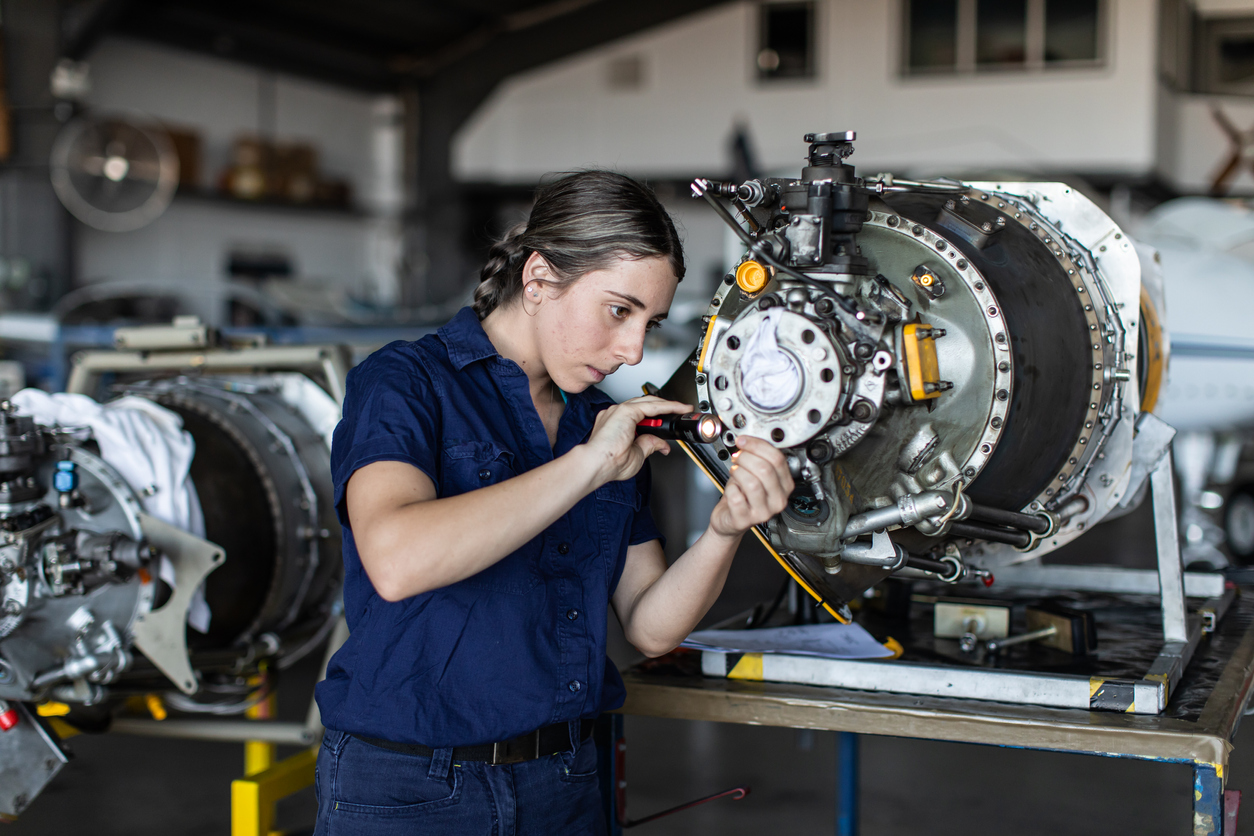The Aerospace Supply Chain: From Crisis to Opportunity
AE Industrial Partners' David Rowe and Bryan McElwee examine the lasting impact of COVID-19 on the aerospace supply chain

In 2020, the highly complex network of suppliers that commercial aerospace original equipment manufacturers (OEMs) relied on was upended by the tsunami that was COVID-19. In retrospect, the pandemic represented the greatest existential threat to aerospace in most people’s lifetimes and brought the industry to its knees. Arriving on the heels of the Boeing 737 MAX grounding, which had already caused disruptions for supply chains and air travel, the pandemic had a devastating effect on the aerospace industry.
According to the International Air Transport Association (IATA), revenue passenger kilometers (RPKs), the most common measure of travel demand, fell by almost 95% in April 2020 compared to April 2019, the sharpest decline in aviation history. In addition, the market for refurbished planes froze, while orders for new aircraft plummeted. The result: an industrywide net loss of $201 billion between 2020 and 2022.
Three years later, the industry is recovering, but not without some after-effects and hard learned lessons. With COVID-19 no longer an epidemic, and the recertification of the 737 MAX family progressing, there is strong demand for new aircraft, especially in Asia, while U.S. domestic travel has come roaring back. The IATA forecasts that the airline industry will book a net operating profit of $9.8 billion in 2023—the first profitable year since 2019. Meanwhile, the worldwide commercial aviation fleet is expected to expand 33% to over 36,000 aircraft by the end of 2033, according to Oliver Wyman.
Amid this recovery, suppliers will need to be strategic about the capital they secure, while for investors, due diligence and investment timing will be critical.
The COVID-19 Shock on Suppliers
To better understand where we are today, it helps to understand the magnitude of the abyss aerospace suppliers were cast into during the pandemic. Gross orders for aircraft from Boeing and Airbus combined plummeted from 1,922 in 2018 to 567 in 2020, dramatically impacting demand for new parts. According to the IATA and McKinsey & Company’s 2022 report, OEMs’ return on invested capital, which had outpaced airlines prior to the pandemic, fell to -26% in 2020 and -2% in 2021.
Related content: Dealmaker Q&A: HC Private Investments on Prince Industries’ Acquisition of Vulcan Machine
Meanwhile, companies in the maintenance, repair and overhaul (MRO) sector reported a decline in revenues of 35% on average – a market impact that Oliver Wyman called a “black swan” event. This decline could have been worse, but many MRO providers pivoted to supporting the cargo markets, which were buoyed by sharp growth in e-commerce during COVID-19. While aerospace supply chains have typically been designed to withstand fluctuations in demand of up to 15%, losing 95% of demand in less than a month was a deep shock that organizations had not contemplated.
Suppliers reacted the only way they could. Conservation of capital and reducing discretionary spending became priority one. In addition, they rethought their labor strategies, resulting in a reduction in workforces virtually across the board.
Bouncing Back, But Not Without Challenges
Most suppliers survived only thanks to a combination of strategic adjustments and a large dose of government stimulus. Gradually, aircraft production came back online as travelers returned to the skies, while OEMs snapped up what inventory was available, eroding existing buffer stock that suppliers had kept on hand. But as stimulus programs have disappeared, many suppliers are finding it difficult to recalibrate their cost structures.
As the industry bounces back and orders for aircraft accelerate, the good news doesn’t come without challenges. This massive growth spurt will require a herculean effort to speed up production at a time when OEMs are putting more pressure on suppliers whose capital reserves are depleted.
Related content: A&D Dealmakers Persist Amid Frustratingly Slow M&A Recovery
Adding to this complexity is the sprawling nature of aerospace supply chains. Today, the average American commercial aerospace OEM has more than 200 tier-1 suppliers and more than 12,000 second- and third-tier suppliers. The picture is further complicated by the need to maintain high safety standards and regulatory conformance, while ramping up production in a coordinated manner across a large number of suppliers.
Heightened demand from OEMs is complicated by the fact that the labor needed to create complex parts that go into commercial aircraft is at an all-time premium. Many skilled workers were let go when demand for parts dried up, and they have since moved on to other industries. Suppliers need to either recapture workers who departed during the pandemic or attract and retain new skilled labor. This will require an injection of capital at a time when they are already stretched financially and facing both rising costs for raw materials and a higher cost of debt.
The Role of New Capital
With thousands of new aircraft to be built, new route structures being rolled out to support economic growth and thousands of refurbished aircraft replacing older planes, there are many needs to address. Fortunately, there are abundant sources of new capital in the middle market. Moreover, because most OEM suppliers are private entities that do not face the quarterly earnings pressure of public companies, their ability to manage margins and capital is quite flexible.
Having learned some hard lessons from COVID-19, suppliers will need to be strategic about how they deploy the capital they secure, and focus on solving three key challenges: labor, technology, and supply chain transparency and monitoring. Below are some steps they can take to get back on top of their supply chains:
- Labor: Even with the offer of higher salaries, finding trained labor to replace employees lost during COVID-19 is a difficult proposition in an era of rising costs. We are seeing an increasing number of suppliers establishing apprenticeship partnerships with technical schools, making earlier contact with qualified college candidates, and subsidizing training. G.S. Precision launched the GSP School of Manufacturing Technology with Vermont Technical College—a program that provides opportunities for students to work full time while pursuing an associate degree. GSP pays for all coursework-related costs with a two-year commitment upon completion. The program has a 72.9% success rate of students staying beyond two years.
- Technology: Suppliers are also leveraging new technologies, such as Artificial Intelligence (AI), automation and 3D printing for parts and tooling. General Electric has used 3D printing to create a fuel nozzle for the LEAP high-bypass turbofan engine produced by CFM International. Companies are also starting to leverage AI tools such as predicative analytics to better anticipate failure rates, control demand for hardware and achieve other efficiencies.
- Supply Chain Transparency and Monitoring: When suppliers were experiencing manageable demand variation, they had little incentive to invest in greater supply chain visibility. Given the limitations companies were working under during COVID-19, the supply chain did an impressive job of reacting and surviving in a very chaotic environment. Informed by the last three years, the best companies today are focusing on productivity and lean processes. Blue Raven Solutions is one such example: a military-focused supply chain management business that uses a proprietary supply chain tracking software called “Sedna” to repair broken supply chains and re-source mission critical parts that are no longer being produced.
With the aerospace industry rebounding strongly from a difficult three years, there is ample opportunity for suppliers to be nimble and access capital to make key investments. Those companies that are slower to react or unable to fund capital investments—many of them smaller organizations—face the prospect of losing market share to their peers that made strategic investments in personnel and technology, and are able to operate more effectively in a post-COVID-19 environment. As this dynamic continues to play out amid elevated interest rates, we expect to see a continued wave of consolidation across the supplier landscape over the near to medium term.
For investors in the sector, volatility is here to stay until at least 2025. The timing of investments, company selection and access to industry expertise will be critical as the supply chain slowly returns to equilibrium.
David Rowe is a managing partner at AE Industrial Partners and the co-founder of its predecessor firm AeroEquity. He has over thirty years of experience managing aerospace investments.

Bryan McElwee is a partner at AE Industrial Partners. He has over ten years of experience in the aerospace industry, holding roles in engineering, sourcing, and operations.

Middle Market Growth is produced by the Association for Corporate Growth. To learn more about the organization and how to become a member, visit www.acg.org.


